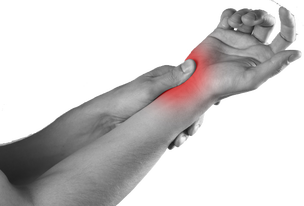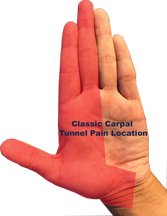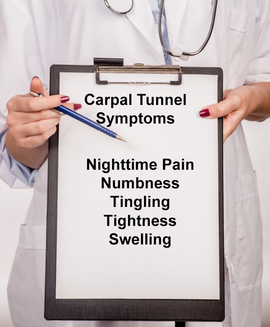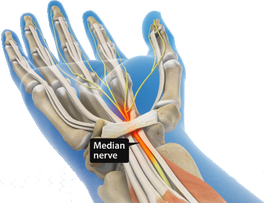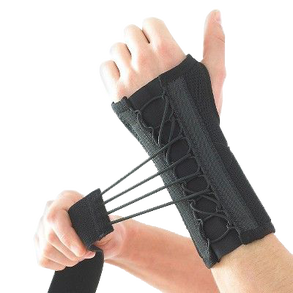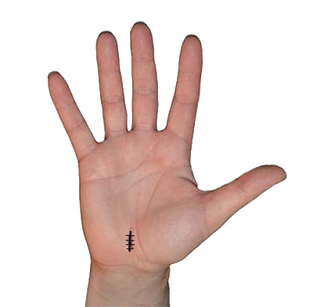What is Carpal Tunnel Syndrome
|
For most people, it is important to use and rely on your hands and fingers throughout your day. Everything from gripping a pen to turning a doorknob to holding a book requires the use of your hands and fingers. Many people have no issues completing such activities and take for granted how often they use their hands and fingers every day. Others, though, are extremely aware of their hands and fingers because of the pain, numbness, tingling, and other symptoms associated with a condition called Carpal Tunnel Syndrome.
Carpal Tunnel Syndrome - also known as median nerve compression - occurs when the median nerve that runs to the hand is compressed. It lies in a "tunnel" bound by unforgiving and very hard ligaments between the carpal bones. If the median nerve then swells and gets inflamed, it becomes enlarged. It has no space for that enlargement and becomes compressed. The symptoms of Carpal Tunnel Syndrome occur most commonly in the thumb, index, and middle fingers. |
Common Carpal Tunnel Syndrome Symptoms
|
If you have been dealing with strange or painful feelings in your hands or fingers, you may be suffering from this condition. You must have your potential Carpal Tunnel Syndrome diagnosed by a medical professional to ensure that you can begin your treatment right away.
When you make an appointment with our premier orthopedic surgeons at Atlanta Bone and Joint Specialists, we will begin to diagnose Carpal Tunnel Syndrome by checking for the following symptoms in the carpal tunnel area:
|
Diagnosis of Median Nerve Compression
|
When a patient comes to Atlanta Bone and Joint Specialists complaining of mild to severe Carpal Tunnel Syndrome, our rheumatoid arthritis experts will perform certain tests and examinations to determine if the patient is suffering from Carpal Tunnel Syndrome.
The most common methods of diagnosing Carpal Tunnel Syndrome include:
|
Causes
|
Unfortunately, many things can affect the carpal area and even the smaller carpal tunnels, so the potential for developing Carpal Tunnel Syndrome extends to many people. Early diagnosis and detection are key to relieving symptoms and eliminating the possibility for limited wrist motion or severe pain in the fingers, especially the thumb muscles.
There are some common causes of the condition that our joint experts will look for, including:
|
Conservative Treatment
|
After completing diagnostic tests such as a physical exam, nerve conduction study, or Magnetic Resonance Imaging (MRI), your bone and a joint specialist will develop a clear course of treatment customized for your situation.
As with most chronic conditions, our physicians at Atlanta Bone and Joint Specialists will begin with non-surgical treatments before jumping to a more extreme option such as Carpal Tunnel Syndrome surgery. Our doctors recommend a variety of conservative management options:
|
Surgical Treatment of Carpal Tunnel Syndrome
|
Our physicians at Atlanta Bone and Joint Specialists will try as many conservative treatment options as possible before moving on to surgery. If it is determined that endoscopic surgery is necessary, our experts will relieve pressure and pain with minimally invasive surgery.
Minimally invasive surgery for carpal tunnel release is quite easy. It involves a small incision in the middle of the palm side of the hand. Once arriving at the roof of the tunnel, the surgeon then releases the upper boundary of the carpal tunnel- the transverse carpal ligament. The nerve is no longer compressed by the rigid boundary and immediately gets its blood flow restored by removing this ligament. Following the surgical procedure, you should be able to get back to your normal, pain-free life quickly. |
Rehabilitation following Surgery
|
Post-operative care after carpal tunnel surgery is relatively easy. Symptoms experienced before surgery tend to go away within the first day after the procedure. Stitches routinely stay in for 2 weeks to let the incision heal. You cannot get the incision wet in the first two weeks after surgery. Once stitches are removed at the 2-week mark, you can return to activity as normal! We have no early restrictions because we want you to get back to a pain-free life as fast as possible!
|
Do You Think You May Be Developing Carpal Tunnel Syndrome? Contact Atlanta Bone and Joint Specialists today!
If you believe that the pain and numbness you are experiencing in your hands and fingers may be due to Carpal Tunnel Syndrome, contact Atlanta Bone and Joint Specialists to schedule an appointment for a consultation. Our experts understand the challenge of medical conditions and will work diligently to relieve the pain and pressure you are feeling in your hands. Contact us today to find out more about Carpal Tunnel Syndrome and how our physicians can get you back on your way to a pain-free life.
Office HoursMon-Fri: 9AM-5PM
|
Telephone |
High School Football Season Added Coverage HoursSaturdays During High School Football Season
Injury Clinic is for INJURED PLAYERS ONLY. Snellville ONLY. 9AM-10AM MEDIA ROOM |

